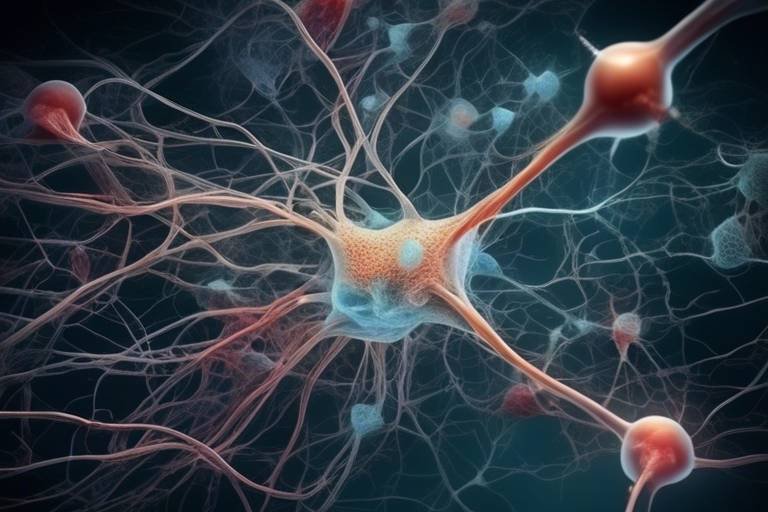Ontology and Metaontology: An Overview
Welcome to the fascinating world of ontology and metaontology! These philosophical concepts are not just academic jargon; they are the backbone of our understanding of existence itself. Imagine trying to unravel the fabric of reality, where every thread represents an entity, a concept, or a relationship. That's what ontology aims to do—it seeks to categorize and clarify what exists and how different entities relate to one another. On the flip side, metaontology takes a step back and asks, "What is ontology really about?" It probes the very nature and significance of these studies, essentially questioning the questions we pose about existence. This article will take you on a journey through these intriguing concepts, highlighting their relevance not only in philosophy but also in fields like computer science, linguistics, and artificial intelligence.
At its core, ontology is the study of being and existence. It digs deep into the categories of being and examines their relationships, providing a framework that helps us understand various entities in the universe. Think of ontology as the ultimate categorizer of reality—like a librarian organizing books in a library, ensuring that each book (or entity) has its rightful place. This classification is crucial because it allows us to explore profound questions such as, "What does it mean for something to exist?" and "How do different entities interact with one another?" By providing a structured approach to understanding existence, ontology lays the groundwork for discussions in many other disciplines.
To grasp ontology fully, we need to familiarize ourselves with some key concepts that serve as its foundation. These include entities, properties, and relations. Each of these elements plays a vital role in shaping our understanding of reality. For instance, entities can be anything from physical objects like trees and cars to abstract ideas like love and justice. Properties describe the characteristics of these entities, while relations define how entities interact with one another. This triad forms the backbone of ontological studies, helping clarify the nature of reality and enabling us to articulate our thoughts more effectively.
Entities can be classified into two main categories: abstract and concrete. Understanding these distinctions is crucial for a comprehensive ontology. Abstract entities, such as numbers, concepts, and theories, exist independently of physical objects. They are like shadows—real in their own right, yet intangible. On the other hand, concrete entities are tangible and can be perceived through our senses. They are the things we can touch, see, and interact with daily. By distinguishing between these two types, we can better navigate the complex landscape of existence.
Abstract entities raise fascinating questions about existence and representation in ontology. For example, consider the number three. It exists as a concept, yet you can't physically touch or see it. It challenges our understanding of what it means to "exist." Are abstract entities less real than concrete ones, or do they hold a different kind of reality? These questions are pivotal in ontological discussions, pushing us to rethink our assumptions about existence.
Concrete entities, in contrast, are the building blocks of our everyday experiences. They are the chairs we sit on, the trees we see, and the people we interact with. Their significance in ontological discussions lies in how they ground our understanding of reality. Without concrete entities, our discussions about existence might feel like castles in the air—beautiful but lacking a solid foundation. By studying these tangible entities, we can better appreciate the complexities of existence and the relationships that bind various entities together.
Ontological categories classify entities based on their characteristics, helping philosophers and scientists articulate the nature of different types of existence. These categories serve as a map, guiding us through the intricate web of reality. For example, we might categorize entities as living or non-living, natural or artificial, and so forth. This classification is not just an academic exercise; it has real-world implications. In fields like computer science and artificial intelligence, ontological categories help create frameworks that allow machines to understand and interact with the world more effectively, bridging the gap between human and machine understanding.
While ontology focuses on what exists, metaontology takes a step back to investigate the nature, scope, and significance of ontology itself. It addresses critical questions about what ontology is and how it should be conducted. Think of metaontology as a philosophy of philosophy, where the aim is to scrutinize the very foundations upon which ontological discussions are built. This exploration is vital for ensuring that our inquiries into existence are grounded in sound reasoning and methodology.
In this section, we highlight critical questions in metaontology. Questions such as:
- What constitutes existence?
- Are there different kinds of existence?
- How do we validate different ontological theories?
These questions challenge us to think critically about the frameworks we use to understand existence. They force us to confront the assumptions that underpin our ontological inquiries and push us toward more rigorous philosophical discourse.
Exploring how metaontology applies to real-world scenarios, including its influence on technology and artificial intelligence, reveals its practical significance beyond philosophical discourse. In an age where technology is rapidly evolving, understanding the foundational principles of existence can guide the development of smarter and more intuitive systems. For example, in artificial intelligence, metaontological insights can help create algorithms that better understand and categorize the complexities of human knowledge, ultimately leading to machines that can engage with the world in more meaningful ways.
The study of ontology is not without its challenges. It faces various debates, particularly over realism versus anti-realism, and the implications of language on our understanding of existence. These discussions are crucial for refining our ontological frameworks and ensuring they remain relevant in an ever-changing world.
This section examines the ongoing debate between realism, which posits that entities exist independently of our perceptions, and anti-realism, which argues that existence is contingent upon our conceptual frameworks. This philosophical tug-of-war challenges us to consider the implications of our beliefs about existence and how they shape our understanding of reality.
Language plays a pivotal role in shaping our understanding of existence and entities. The structures and limitations of language can influence our ontological perspectives, leading to different interpretations of what it means to exist. This subheading explores how linguistic nuances can enrich or complicate our philosophical inquiries, emphasizing the importance of clear communication in ontological discussions.
Here are some common questions that often arise regarding ontology and metaontology:
- What is the difference between ontology and metaontology? Ontology studies what exists, while metaontology examines the nature and significance of those studies.
- Why is ontology important? It helps us categorize and understand the complexities of existence, influencing various fields like science and technology.
- How does language affect ontology? Language shapes our perceptions of reality, influencing how we categorize and understand entities.

Understanding Ontology
Ontology is a fascinating branch of philosophy that dives deep into the fundamental nature of being and existence. Imagine it as the ultimate blueprint of reality, where we dissect what it means for something to "be." It’s not just about the tangible things we can touch and see; it’s also about abstract concepts that float around in our minds. Think about it: when you ponder the idea of 'justice' or 'beauty,' you’re engaging with abstract entities that, while not physically present, hold immense significance in our understanding of the world.
This exploration of existence leads us to examine various categories of being and their interrelationships. For instance, ontology helps us differentiate between what is real and what is merely a figment of our imagination. It raises questions like: What does it mean for something to exist? Are numbers real, or are they just human-made constructs? By tackling these queries, ontology provides a framework that underpins not just philosophical debates but also practical applications in fields like computer science and artificial intelligence.
At its core, ontology seeks to answer some of the most profound questions humanity has ever faced. It challenges us to think critically about the world around us and the very fabric of reality. When we categorize entities, we start to see patterns and relationships that might not be immediately obvious. For example, consider the difference between living beings and inanimate objects. While both exist, they do so in fundamentally different ways, and understanding these differences is crucial for anyone delving into ontological studies.
In the realm of ontology, we also encounter the concept of existential categories. These categories help us classify entities based on their characteristics, such as:
- Substance: The essence of what an entity is.
- Attribute: The properties or qualities an entity possesses.
- Relation: How entities interact with one another.
By understanding these categories, philosophers and scientists can articulate the nature of different types of existence more clearly. This classification not only aids in philosophical discourse but also has practical implications in various fields. For instance, in computer science, ontology is crucial for developing knowledge representation systems that can accurately model real-world entities and their relationships. In essence, ontology serves as a bridge between abstract philosophical concepts and practical applications, making it a vital area of study for anyone interested in the nature of reality.

Key Concepts in Ontology
Ontology, at its core, is a rich tapestry woven from various threads of thought that seek to define and categorize the essence of existence. One of the fundamental concepts in ontology is the notion of entities. Entities can be anything that exists or can be conceived to exist, ranging from physical objects like trees and mountains to abstract concepts such as love and justice. Understanding what qualifies as an entity is crucial, as it lays the groundwork for all subsequent discussions in ontological studies.
Another key element is the idea of properties. Properties are the characteristics or attributes that entities possess. For example, the color red is a property of an apple, while the concept of 'justice' may have properties like fairness and equality. In ontology, properties help us articulate how entities relate to one another and the world around them. This leads us to the third important concept: relations. Relations describe how entities and their properties interact. They can be simple, like the relationship between a cat and its owner, or complex, like the intricate web of social relationships in a community.
To further clarify these concepts, let’s look at a table that summarizes the distinctions between entities, properties, and relations:
| Concept | Description | Examples |
|---|---|---|
| Entities | Things that exist or can be conceived | Tree, Love, Justice |
| Properties | Characteristics or attributes of entities | Red (for an apple), Fairness (for justice) |
| Relations | How entities and properties interact | Owner-pet relationship, Social relationships |
When we dive deeper into ontology, we encounter various types of entities that can be categorized into abstract and concrete entities. Abstract entities, such as numbers and concepts, exist independently of any physical manifestation. They raise intriguing questions about existence—do they exist in the same way that physical objects do? On the other hand, concrete entities are tangible and can be perceived through our senses, like a flower or a car. This distinction is pivotal in ontological discussions as it shapes our understanding of reality.
Moreover, ontological categories help classify these entities based on their characteristics. These categories are essential for philosophers and scientists alike as they provide a framework to articulate the nature of different types of existence. For instance, we might categorize entities into living and non-living, or sentient and non-sentient. Such classifications enable us to navigate the complex landscape of existence more effectively.
In summary, the key concepts of entities, properties, and relations serve as the backbone of ontology. They help us decipher the intricate web of existence and provide a foundation for philosophical inquiry. By understanding these concepts, we not only gain insight into the nature of reality but also enhance our ability to engage in meaningful discussions about the world around us.

Types of Entities
When diving into the realm of ontology, one of the first things we encounter is the concept of entities. These entities are the building blocks of our understanding of existence and can be broadly categorized into two main types: abstract entities and concrete entities. Each category has its own unique characteristics and implications, shaping how we perceive and engage with the world around us.
Abstract entities are fascinating because they exist independently of any physical manifestation. Think of them as the invisible threads that weave through our understanding of reality. They include concepts like numbers, ideas, and theories. For instance, the concept of 'justice' is an abstract entity; while we can discuss it, we can't touch or see it in a physical sense. This leads us to ponder profound questions about existence itself: What does it mean for something to "exist" if it cannot be perceived? The study of abstract entities pushes us to explore the boundaries of reality and representation in ontology.
On the other hand, we have concrete entities, which are the tangible aspects of our universe. These are the things we can see, touch, and interact with in our daily lives. Examples include trees, animals, and buildings. Concrete entities are crucial for our survival and understanding of the world, as they provide the context in which we experience our lives. Imagine walking through a forest; the trees, the soil, and the wildlife are all concrete entities that contribute to the richness of that experience. They represent a reality that is accessible and relatable, grounding our abstract thoughts in something we can physically engage with.
Understanding these distinctions between abstract and concrete entities is not just an academic exercise; it has real-world implications. For example, in fields like computer science and artificial intelligence, distinguishing between these types of entities can inform how we design systems that interact with human knowledge and experience. In programming, abstract entities might be represented through data structures, while concrete entities could be the actual objects manipulated by code.
Moreover, the interplay between these two types of entities can lead to rich discussions about existence and reality. How do abstract entities influence our understanding of concrete ones? Do our experiences with concrete entities shape our concepts of abstract entities? These are the kinds of questions that not only fuel philosophical inquiry but also inform practical applications in technology and beyond.
In summary, the exploration of in ontology reveals a complex landscape where abstract and concrete coexist, each enriching our understanding of existence in its own way. By recognizing the significance of both categories, we can better appreciate the intricate tapestry of reality that surrounds us.

Abstract Entities
When we delve into the realm of , we step into a fascinating world that transcends the physical. These entities, which include concepts like numbers, ideas, and theories, exist independently of the tangible world around us. Imagine trying to grasp the concept of infinity or the notion of love; these are not things you can touch or see, yet they hold significant meaning in our lives. This characteristic of abstract entities raises profound questions about their existence and how we represent them in our understanding of reality.
One of the most intriguing aspects of abstract entities is their independence from physical objects. For instance, the number "5" exists regardless of whether there are five apples on a table or not. This independence prompts us to consider how we interact with these entities. Do they exist in some metaphysical realm, or are they merely constructs of our minds? This debate is central to the study of ontology and challenges our perceptions of reality.
Moreover, abstract entities play a crucial role in various fields, including mathematics, philosophy, and even computer science. In mathematics, abstract entities form the basis of theories and proofs, while in philosophy, they help us explore the nature of existence itself. For example, consider the following table that illustrates the relationship between abstract entities and their applications in different fields:
| Abstract Entity | Field of Application | Example |
|---|---|---|
| Numbers | Mathematics | Calculating areas |
| Concepts | Philosophy | Understanding justice |
| Theories | Computer Science | Algorithm design |
As we engage with abstract entities, we often find ourselves questioning their representation. How do we communicate ideas that cannot be physically manifested? This is where language and symbols come into play. The way we articulate abstract concepts affects our understanding of them. For instance, the word "freedom" evokes different interpretations based on cultural and personal contexts. Thus, the study of abstract entities is not just about their existence but also about how they are perceived and understood through language.
In conclusion, abstract entities challenge our conventional understanding of existence. They prompt us to explore deeper philosophical questions about reality, representation, and the very essence of being. As we continue to investigate these entities, we uncover layers of meaning that enrich our comprehension of the world and our place within it. The journey into the realm of abstract entities is not just an academic pursuit; it is a profound exploration of what it means to exist and to understand existence itself.

Concrete Entities
Concrete entities are the building blocks of our tangible reality. They are the objects, beings, and phenomena that we can perceive through our senses—those things we can touch, see, hear, taste, or smell. Think about it: when you walk into a room, you encounter a variety of concrete entities, from the furniture to the people present. These entities are not just mere figments of our imagination; they occupy physical space and have a presence that can be measured and interacted with. This makes them incredibly significant in the study of ontology, as they provide a clear and relatable context for discussing existence.
In the realm of ontology, concrete entities can be categorized into several types. For instance, we can distinguish between living entities, such as animals and plants, and inanimate entities, like rocks and buildings. Each category has its own unique properties and relationships that contribute to our understanding of the world. For example, consider a tree: it is a living entity that interacts with its environment, providing oxygen and shelter for various species. In contrast, a rock is an inanimate entity that remains relatively unchanged over time, serving as a fundamental component of the earth's crust.
The significance of concrete entities extends beyond mere categorization. They invite us to ponder deeper questions about existence and our perception of reality. How do we know that these entities exist? What role do they play in our lives? These questions lead us to explore the relationships between different concrete entities and their interactions within the larger framework of existence. For instance, the relationship between a predator and its prey illustrates the dynamic interplay of life forms in an ecosystem, highlighting the interconnectedness of all concrete entities.
Moreover, concrete entities serve as a reference point for abstract concepts. When we talk about ideas such as "freedom" or "justice," we often anchor these discussions in concrete examples. For instance, we might discuss freedom in terms of a person’s ability to move freely within a city or justice in terms of the legal system protecting individuals' rights. This interplay between the abstract and the concrete enriches our understanding of both realms, emphasizing the importance of concrete entities in philosophical discourse.
In summary, concrete entities are not just physical objects; they are integral to our understanding of existence and reality. They provide a foundation for exploring complex philosophical concepts and facilitate our grasp of the world around us. Without concrete entities, our discussions about ontology would lack the necessary context to engage meaningfully with the nature of being. As we delve deeper into the study of ontology, recognizing the role of concrete entities will undoubtedly enhance our comprehension of the intricate tapestry of existence.

Ontological Categories
Ontological categories serve as the foundational framework for classifying entities based on their characteristics and relationships. Think of these categories as the different shelves in a library, where each shelf holds books of a similar genre. Just as a library organizes its collection to help readers find what they need, ontological categories help philosophers and scientists articulate and navigate the complex landscape of existence. By categorizing entities, we can better understand how they interact, relate, and contribute to the fabric of reality.
In essence, ontological categories can be divided into several key types, each representing a distinct aspect of existence. These include:
- Substance: Refers to entities that exist independently, such as objects and living beings.
- Properties: Characteristics or qualities that entities possess, like color, size, or shape.
- Relations: The connections or interactions between different entities, such as cause and effect.
- Events: Occurrences or happenings that involve changes or interactions among entities.
Understanding these categories is crucial for various fields, including philosophy, computer science, and artificial intelligence. For instance, in computer science, ontological categories help in the development of knowledge representation systems, enabling machines to process and understand information in a human-like manner. Similarly, in linguistics, these categories assist in analyzing how language reflects our conceptual understanding of the world.
Moreover, ontological categories are not static; they evolve over time as our understanding of reality deepens. New discoveries and insights can lead to the reclassification of entities, highlighting the dynamic nature of ontology. For example, the emergence of quantum physics has challenged traditional categories of existence, prompting philosophers to reconsider what it means for something to 'exist.' This ongoing dialogue between different fields underscores the significance of ontological categories in shaping our comprehension of reality.
Ultimately, ontological categories provide a structured approach to exploring the myriad forms of existence. They invite us to ask deeper questions about the nature of reality and our place within it, making ontology a vital area of inquiry in both philosophical and practical contexts.
- What is ontology? Ontology is the philosophical study of being, existence, and the categories of being.
- Why are ontological categories important? They help organize our understanding of different types of entities and their relationships, facilitating clearer communication and analysis across various fields.
- How do ontological categories apply to artificial intelligence? They are used to develop knowledge representation systems that enable AI to understand and process information like humans do.
- Can ontological categories change over time? Yes, as new discoveries and insights emerge, our understanding and classification of entities can evolve.

Introduction to Metaontology
Metaontology is a fascinating branch of philosophy that dives deep into the very nature of ontology itself. While ontology is concerned with what exists, metaontology takes a step back to ask, "What do we mean when we talk about existence?" This inquiry is not just academic; it has profound implications across various fields, including artificial intelligence, linguistics, and computer science. By examining the foundations of ontological theories, metaontology seeks to clarify the assumptions and implications underlying our understanding of existence.
To put it simply, if ontology is like exploring the contents of a vast library filled with books about different entities and their relationships, then metaontology is akin to scrutinizing the library's cataloging system. It asks questions about how we categorize these books, what criteria we use to define their existence, and whether the system itself is sufficient to capture the complexity of reality. This reflective process is essential, as it allows us to evaluate the validity and reliability of the ontological frameworks we employ.
In metaontology, several critical questions arise that challenge our conventional perspectives:
- What is existence? This fundamental question prompts debates about the nature of being and whether existence is a property that entities possess.
- How do we validate different ontological theories? Here, metaontology examines the criteria we use to determine the credibility of various ontological claims.
- What role does language play in our understanding of ontology? This question explores how linguistic structures shape our perceptions of existence and categories of being.
Through these inquiries, metaontology does not merely add layers of complexity to philosophical discourse; it also has practical applications. For instance, in the realm of artificial intelligence, understanding the distinctions between different types of entities can inform the development of more sophisticated algorithms that better mimic human reasoning. Similarly, in linguistics, insights from metaontology can enhance our comprehension of how language influences thought and categorization.
In essence, metaontology serves as a critical lens through which we can examine the assumptions that underpin our ontological beliefs. By engaging with these metaontological questions, we can refine our understanding of existence, leading to more robust and nuanced philosophical discussions. This exploration not only enriches our theoretical frameworks but also has tangible implications in various fields, making it a vital area of study for anyone interested in the philosophy of being.

Metaontological Questions
When diving into the realm of metaontology, we encounter a plethora of intriguing questions that challenge our understanding of existence and reality itself. These questions are not just academic; they resonate with our everyday experiences and the way we conceptualize the world around us. At the heart of metaontology lies the inquiry into what ontology truly is. This leads us to ponder: What does it mean for something to exist? Are we merely cataloging the universe, or are we uncovering deeper truths about the nature of being?
One of the primary metaontological questions revolves around the nature of existence. For instance, does existence precede essence, or is it the other way around? This question has philosophical roots that trace back to existentialist thought, prompting us to consider whether entities have inherent properties or if those properties are assigned through human perception and language. Additionally, we must ask ourselves: How do we validate different ontological theories? The criteria for validating these theories can vary significantly, leading to debates about what constitutes a "valid" ontology.
Moreover, the implications of these questions extend beyond philosophical discourse. They influence various fields, including computer science and artificial intelligence, where understanding the nature of entities is crucial for developing algorithms and systems that mimic human cognition. In this light, we can categorize metaontological questions into several key areas:
- Existential Questions: What does it mean for something to exist? How do we determine the existence of abstract entities?
- Validity of Theories: What criteria do we use to assess the validity of different ontological theories? Are some theories more applicable than others?
- Language and Ontology: How does language shape our understanding of existence? Does the structure of our language influence our ontological perspectives?
These questions not only stimulate intellectual curiosity but also highlight the interconnectedness of ontology and metaontology. As we explore these inquiries, we realize that the answers may not be straightforward; rather, they invite ongoing dialogue and reflection. In essence, metaontological questions serve as a bridge, linking abstract philosophical concepts to practical applications, thereby enriching our understanding of both the world and our place within it.
What is the difference between ontology and metaontology?
Ontology studies the nature of being and existence, while metaontology examines the nature and scope of ontology itself.
Why are metaontological questions important?
These questions help clarify our understanding of existence and influence various fields such as philosophy, computer science, and artificial intelligence.
Can metaontology influence technology?
Yes, insights from metaontology can shape the development of algorithms and systems in technology, particularly in AI, where understanding entities is crucial.

Metaontology in Practice
When we think about metaontology, it might seem like a purely theoretical endeavor, but its implications stretch far beyond the confines of academic philosophy. In fact, metaontology plays a crucial role in various fields, especially in technology and artificial intelligence. By examining the foundational questions about what ontology is and how it operates, we can gain insights that inform practical applications across different domains.
For instance, in the realm of artificial intelligence, understanding the nature of existence and the categorization of entities can significantly enhance how machines interpret and interact with the world. AI systems rely on ontological frameworks to process information, make decisions, and learn from their environments. Thus, the metaontological inquiries into the validity of these frameworks are not just philosophical musings; they have real-world consequences. Think about it: if an AI misinterprets the nature of an entity due to a flawed ontological model, the results could be catastrophic!
Moreover, metaontology encourages us to reflect on the assumptions underlying our technological constructs. When developers create algorithms or data models, they often embed ontological assumptions about the world. By critically examining these assumptions through a metaontological lens, we can identify potential biases and limitations in our systems. This process can lead to the creation of more robust, inclusive, and accurate technologies.
Consider the importance of semantic web technologies. These technologies rely on well-defined ontologies to facilitate data sharing and interoperability across the internet. Metaontology helps us understand the significance of these ontologies and how they can be structured to reflect the complexities of reality. As we navigate through a world increasingly dominated by interconnected data, the insights gained from metaontology can guide us in developing frameworks that better represent the nuances of existence.
In summary, metaontology is not just a philosophical abstraction; it is a practical tool that informs our understanding of technology, AI, and the very frameworks we use to navigate our reality. By engaging with metaontological questions, we can enhance our approaches to problem-solving in technology and ensure that our models align more closely with the complexities of the world we inhabit.
- What is the difference between ontology and metaontology?
Ontology studies the nature of being and existence, while metaontology examines the nature and scope of ontology itself. - How does metaontology influence artificial intelligence?
Metaontology helps clarify the assumptions and frameworks that underpin AI systems, leading to better decision-making and understanding of entities. - Can metaontology be applied outside of philosophy?
Yes, metaontology has practical implications in fields like technology, linguistics, and cognitive science, influencing how we develop and utilize various systems.

Challenges in Ontology
Ontology, the intricate study of being and existence, is not without its challenges. As philosophers and scholars delve deeper into the nature of reality, they encounter a myriad of debates and dilemmas that complicate our understanding of existence. One of the primary challenges is the ongoing debate between realism and anti-realism. These two perspectives offer contrasting views on the nature of entities and their existence. Realism posits that entities exist independently of our perceptions, suggesting a world that is objective and discoverable. In contrast, anti-realism argues that existence is contingent upon our conceptual frameworks, which implies that our understanding of reality is shaped by our interpretations and linguistic constructs.
This debate raises profound questions: If entities exist independently, how do we account for the subjective experiences that shape our understanding of them? Conversely, if existence relies on our conceptual frameworks, what happens to the objective reality that seems to exist beyond our perception? These questions create a tension that challenges the very foundation of ontological inquiry.
Another significant challenge in ontology is the role of language. Language is not merely a tool for communication; it profoundly influences our understanding of existence. The structures and limitations of language can shape our ontological perspectives in ways we may not fully comprehend. For instance, consider how different languages categorize time, space, and relationships. These linguistic differences can lead to varied ontological interpretations across cultures. A clear example is the distinction between countable and uncountable nouns in English, which can affect how we perceive quantities and existence itself.
Moreover, language can create barriers to understanding complex ontological concepts. Philosophical jargon often alienates those not versed in the discipline, leading to misunderstandings about fundamental ideas. This creates a paradox where the very language intended to clarify can obfuscate meaning. Consequently, philosophers must navigate the delicate balance between precise language and accessibility to foster a more inclusive discourse on ontology.
As we explore these challenges, it's essential to recognize that ontology is not just an abstract philosophical endeavor; it has real-world implications. For instance, in fields like artificial intelligence and computer science, ontological frameworks play a critical role in how we design systems that interact with the world. The assumptions we make about existence and entities can significantly influence the effectiveness and ethical considerations of these technologies. Therefore, grappling with these ontological challenges is not merely an academic exercise; it is vital for ensuring that our technological advancements align with a coherent understanding of reality.
In summary, the challenges in ontology—ranging from the realism versus anti-realism debate to the intricate role of language—underscore the complexity of understanding existence. As we continue to navigate these philosophical waters, it becomes increasingly clear that ontology is not just about defining what exists, but also about understanding how we come to know and interpret that existence.
- What is ontology? Ontology is the philosophical study of being, existence, and the categories of being.
- What are the main challenges in ontology? The main challenges include the realism vs. anti-realism debate and the influence of language on our understanding of existence.
- How does ontology apply to technology? Ontological frameworks influence the design and ethical considerations of technologies, particularly in AI and computer science.

Realism vs. Anti-Realism
The debate between realism and anti-realism is one of the most profound discussions in ontology. At its core, realism asserts that entities exist independently of our thoughts, beliefs, and perceptions. In other words, the world is out there, waiting to be discovered, regardless of whether we are aware of it or not. Think of it like a hidden treasure chest buried deep in the ground; it exists whether or not someone has the map to find it. On the other hand, anti-realism challenges this notion by suggesting that our understanding of existence is heavily influenced, if not entirely constructed, by our conceptual frameworks and linguistic practices. This perspective posits that without our interpretations, the world as we know it would not exist. Imagine a painting that only comes to life when viewed by an observer; its existence is contingent upon that very act of observation.
To illustrate the differences between these two positions, consider the following table:
| Aspect | Realism | Anti-Realism |
|---|---|---|
| Existence of Entities | Entities exist independently of our knowledge. | Entities are dependent on our perceptions and concepts. |
| Nature of Truth | Truth is objective and discoverable. | Truth is subjective and constructed through language. |
| Philosophical Implications | Supports a more traditional view of science and metaphysics. | Encourages skepticism towards objective claims. |
This philosophical tug-of-war raises several important questions: Can we ever truly know the world as it is, or are we forever trapped within our interpretations? How does language shape our perceptions of reality? Realists argue that scientific inquiry can uncover truths about the universe, while anti-realists contend that our scientific theories are merely tools for navigating our experiences rather than reflections of an independent reality.
Ultimately, the realism versus anti-realism debate is not just an academic exercise; it has real-world implications. For instance, in fields like artificial intelligence and computer science, how we define existence can influence the development of algorithms and systems. If we lean towards realism, we may design AI that tries to mimic an objective reality. Conversely, an anti-realist approach might lead us to create systems that adapt to user perceptions, emphasizing subjective experience over objective truth.
In conclusion, the clash between realism and anti-realism invites us to reflect on the nature of existence itself. It challenges us to consider how our beliefs shape our understanding of reality and encourages a deeper exploration of the philosophical foundations that underpin our knowledge.
- What is realism in philosophy? Realism is the belief that entities exist independently of our thoughts and perceptions.
- What is anti-realism? Anti-realism posits that our understanding of existence is shaped by our conceptual frameworks and language.
- Why is the realism vs. anti-realism debate important? This debate impacts various fields, including science, linguistics, and artificial intelligence, influencing how we understand and interact with the world.
- Can realism and anti-realism coexist? Some philosophers argue for a pragmatic approach that acknowledges elements of both perspectives, suggesting a nuanced understanding of existence.

The Role of Language in Ontology
Language plays a crucial role in shaping our understanding of ontology and existence. It's not just a tool for communication; it's the very lens through which we perceive reality. Think about it—how we describe things, the words we choose, and the structure of our sentences all influence our conceptual frameworks. For instance, when we categorize entities, the language we use can either clarify or complicate our understanding of those entities. This is where the intersection of linguistics and ontology becomes fascinating.
To illustrate this point, consider how different languages categorize colors. In English, we have a wide array of color terms, but some languages have fewer distinctions. This linguistic variability can lead to different perceptions of reality. If a language doesn't have a word for a certain color, speakers may not recognize it as a distinct entity. This phenomenon raises profound questions: Does language limit our understanding of existence? Or does it merely reflect the entities we are already aware of?
Moreover, the structure of language itself can influence ontological perspectives. For example, the use of nouns versus verbs can indicate whether we view entities as static objects or dynamic processes. In English, we might say, “The cat is on the mat,” which presents the cat as a static entity. However, in some languages, the same concept might be expressed in a way that emphasizes the action, changing our perception of the cat from a mere object to something that is actively involved in a situation.
Additionally, language can create ontological categories that shape our understanding of existence. For example, in philosophical discussions, terms like "substance," "property," and "relation" carry specific meanings that guide our inquiries into the nature of reality. These terms are not just arbitrary labels; they encapsulate complex ideas that can influence how we think about the world. The way we frame questions in ontology—using language—can lead us to different conclusions and insights.
It's also worth noting that the philosophical implications of language in ontology extend to fields like artificial intelligence and computer science. In AI, for instance, how we program machines to understand language affects their ability to comprehend and interact with the world. The ontological assumptions embedded in programming languages can shape the way AI perceives reality. If we want AI to understand human concepts, we must carefully consider the linguistic frameworks we provide them.
In summary, the role of language in ontology is multifaceted and profound. It not only influences how we categorize and conceptualize existence but also impacts the very nature of our inquiries into reality. As we continue to explore these connections, we must remain aware of the powerful interplay between language and ontology, recognizing that our words can shape our worlds in ways we may not fully understand.
Frequently Asked Questions
- What is ontology?
Ontology is the philosophical study of being and existence. It explores the categories of being and their relationships, providing a framework for understanding various entities in the universe.
- What are the key concepts in ontology?
Key concepts in ontology include entities, properties, and relations. These concepts help clarify the nature of reality and how different entities interact with each other.
- What types of entities are studied in ontology?
Entities can be categorized into abstract and concrete types. Abstract entities, like numbers and concepts, exist independently of physical objects, while concrete entities are tangible and can be perceived through the senses.
- What is metaontology?
Metaontology investigates the nature, scope, and significance of ontology itself. It addresses critical questions about what ontology is and how it should be conducted.
- What are some common metaontological questions?
Common metaontological questions include inquiries about the nature of existence and the validity of different ontological theories. These questions help deepen our understanding of how we conceptualize reality.
- How does metaontology apply to real-world scenarios?
Metaontology has practical significance beyond philosophical discourse, influencing areas such as technology and artificial intelligence. It helps shape how we approach complex problems in these fields.
- What challenges does ontology face?
Ontology faces challenges such as the debate between realism and anti-realism, as well as the implications of language on our understanding of existence. These challenges are critical for advancing ontological studies.
- What is the difference between realism and anti-realism?
Realism posits that entities exist independently of our perceptions, while anti-realism argues that existence is contingent upon our conceptual frameworks. This ongoing debate significantly influences ontological discussions.
- How does language impact ontology?
Language shapes our understanding of existence and entities, influencing ontological perspectives. The structures of language can affect how we conceptualize and articulate our thoughts about reality.



















